engine FIAT DUCATO BASE CAMPER 2018 Owner handbook (in English)
[x] Cancel search | Manufacturer: FIAT, Model Year: 2018, Model line: DUCATO BASE CAMPER, Model: FIAT DUCATO BASE CAMPER 2018Pages: 304, PDF Size: 14.93 MB
Page 202 of 304
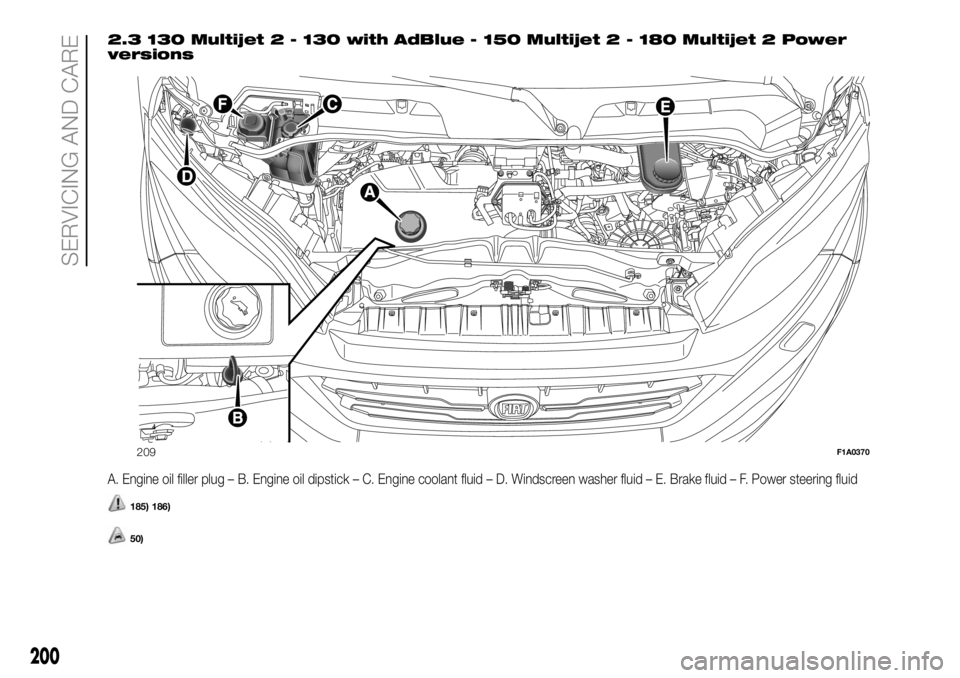
2.3 130 Multijet 2 - 130 with AdBlue - 150 Multijet 2 - 180 Multijet 2 Power
versions
A. Engine oil filler plug – B. Engine oil dipstick – C. Engine coolant fluid – D. Windscreen washer fluid – E. Brake fluid – F. Power steering fluid
185) 186)
50)
209F1A0370
200
SERVICING AND CARE
Page 203 of 304
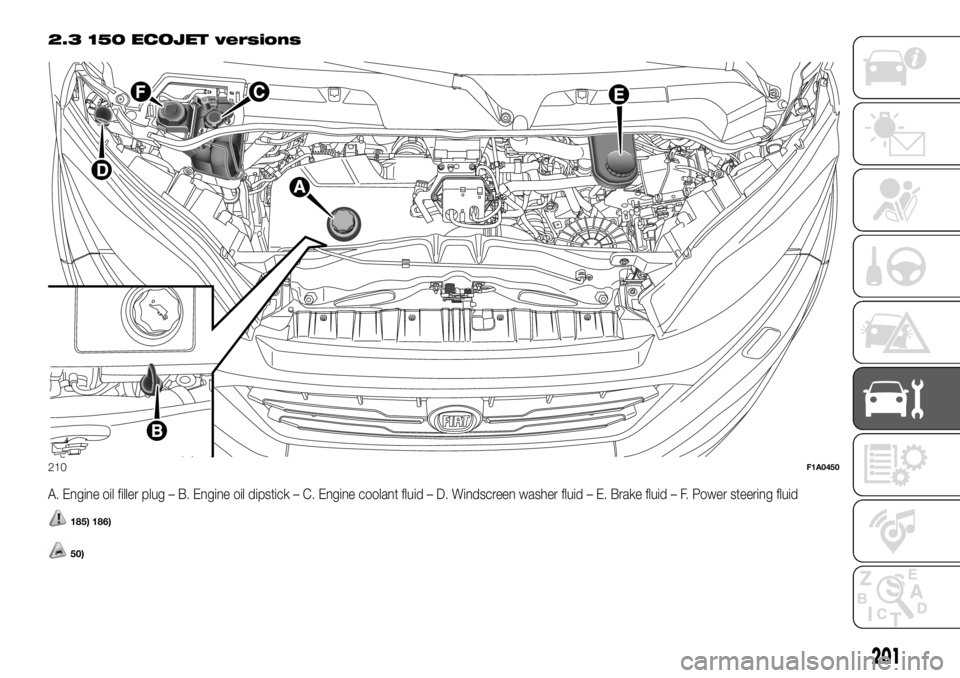
2.3 150 ECOJET versions
A. Engine oil filler plug – B. Engine oil dipstick – C. Engine coolant fluid – D. Windscreen washer fluid – E. Brake fluid – F. Power steering fluid
185) 186)
50)
210F1A0450
201
Page 204 of 304
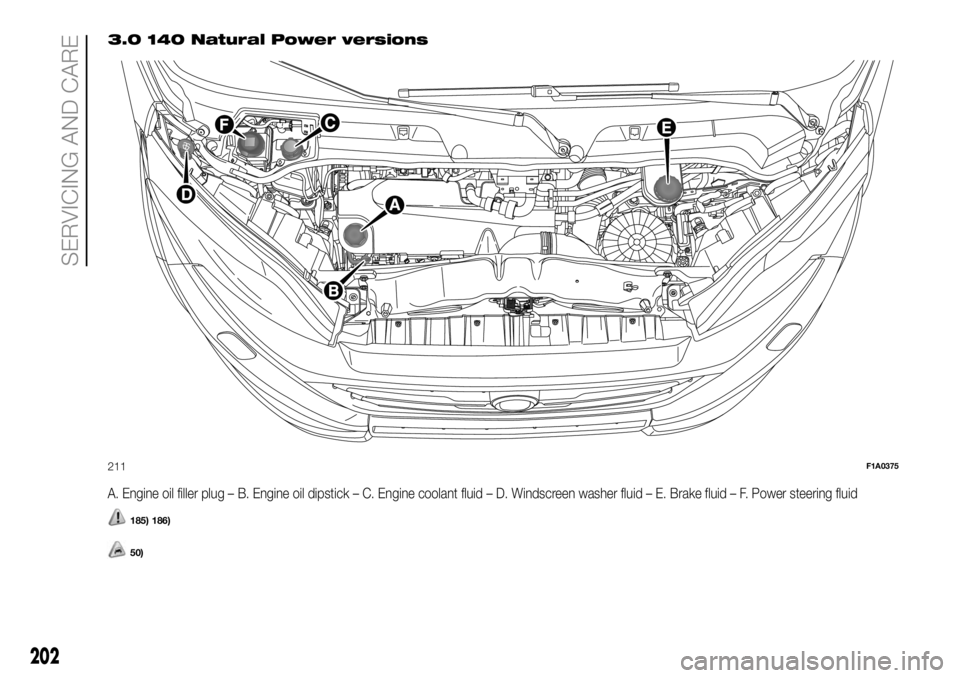
3.0 140 Natural Power versions
A. Engine oil filler plug – B. Engine oil dipstick – C. Engine coolant fluid – D. Windscreen washer fluid – E. Brake fluid – F. Power steering fluid
185) 186)
50)
211F1A0375
202
SERVICING AND CARE
Page 205 of 304
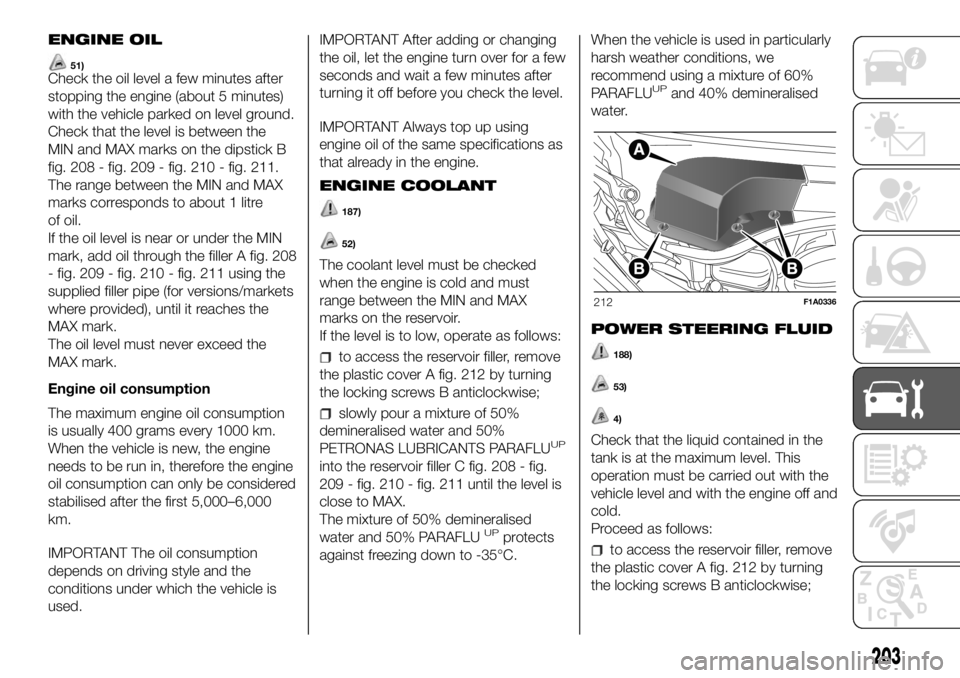
ENGINE OIL
51)Check the oil level a few minutes after
stopping the engine (about 5 minutes)
with the vehicle parked on level ground.
Check that the level is between the
MIN and MAX marks on the dipstick B
fig. 208 - fig. 209 - fig. 210 - fig. 211.
The range between the MIN and MAX
marks corresponds to about 1 litre
of oil.
If the oil level is near or under the MIN
mark, add oil through the filler A fig. 208
- fig. 209 - fig. 210 - fig. 211 using the
supplied filler pipe (for versions/markets
where provided), until it reaches the
MAX mark.
The oil level must never exceed the
MAX mark.
Engine oil consumption
The maximum engine oil consumption
is usually 400 grams every 1000 km.
When the vehicle is new, the engine
needs to be run in, therefore the engine
oil consumption can only be considered
stabilised after the first 5,000–6,000
km.
IMPORTANT The oil consumption
depends on driving style and the
conditions under which the vehicle is
used.IMPORTANT After adding or changing
the oil, let the engine turn over for a few
seconds and wait a few minutes after
turning it off before you check the level.
IMPORTANT Always top up using
engine oil of the same specifications as
that already in the engine.
ENGINE COOLANT
187)
52)
The coolant level must be checked
when the engine is cold and must
range between the MIN and MAX
marks on the reservoir.
If the level is to low, operate as follows:
to access the reservoir filler, remove
the plastic cover A fig. 212 by turning
the locking screws B anticlockwise;
slowly pour a mixture of 50%
demineralised water and 50%
PETRONAS LUBRICANTS PARAFLU
UP
into the reservoir filler C fig. 208 - fig.
209 - fig. 210 - fig. 211 until the level is
close to MAX.
The mixture of 50% demineralised
water and 50% PARAFLU
UPprotects
against freezing down to -35°C.When the vehicle is used in particularly
harsh weather conditions, we
recommend using a mixture of 60%
PARAFLU
UPand 40% demineralised
water.
POWER STEERING FLUID
188)
53)
4)
Check that the liquid contained in the
tank is at the maximum level. This
operation must be carried out with the
vehicle level and with the engine off and
cold.
Proceed as follows:
to access the reservoir filler, remove
the plastic cover A fig. 212 by turning
the locking screws B anticlockwise;
212F1A0336
203
Page 206 of 304
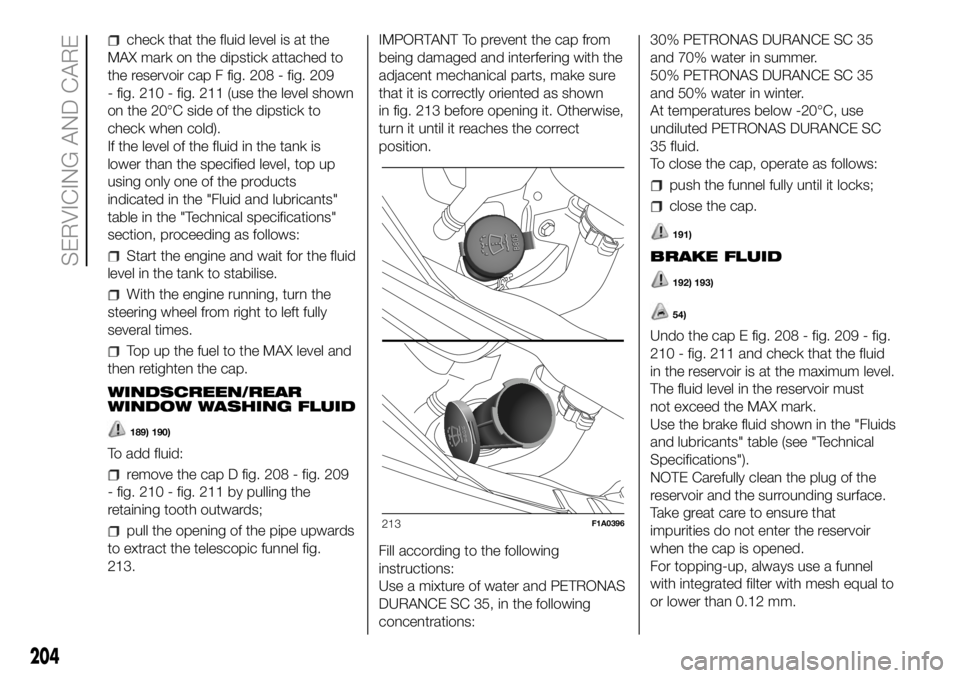
check that the fluid level is at the
MAX mark on the dipstick attached to
the reservoir cap F fig. 208 - fig. 209
- fig. 210 - fig. 211 (use the level shown
on the 20°C side of the dipstick to
check when cold).
If the level of the fluid in the tank is
lower than the specified level, top up
using only one of the products
indicated in the "Fluid and lubricants"
table in the "Technical specifications"
section, proceeding as follows:
Start the engine and wait for the fluid
level in the tank to stabilise.
With the engine running, turn the
steering wheel from right to left fully
several times.
Top up the fuel to the MAX level and
then retighten the cap.
WINDSCREEN/REAR
WINDOW WASHING FLUID
189) 190)
To add fluid:
remove the cap D fig. 208 - fig. 209
- fig. 210 - fig. 211 by pulling the
retaining tooth outwards;
pull the opening of the pipe upwards
to extract the telescopic funnel fig.
213.IMPORTANT To prevent the cap from
being damaged and interfering with the
adjacent mechanical parts, make sure
that it is correctly oriented as shown
in fig. 213 before opening it. Otherwise,
turn it until it reaches the correct
position.
Fill according to the following
instructions:
Use a mixture of water and PETRONAS
DURANCE SC 35, in the following
concentrations:30% PETRONAS DURANCE SC 35
and 70% water in summer.
50% PETRONAS DURANCE SC 35
and 50% water in winter.
At temperatures below -20°C, use
undiluted PETRONAS DURANCE SC
35 fluid.
To close the cap, operate as follows:
push the funnel fully until it locks;
close the cap.
191)
BRAKE FLUID
192) 193)
54)
Undo the cap E fig. 208 - fig. 209 - fig.
210 - fig. 211 and check that the fluid
in the reservoir is at the maximum level.
The fluid level in the reservoir must
not exceed the MAX mark.
Use the brake fluid shown in the "Fluids
and lubricants" table (see "Technical
Specifications").
NOTE Carefully clean the plug of the
reservoir and the surrounding surface.
Take great care to ensure that
impurities do not enter the reservoir
when the cap is opened.
For topping-up, always use a funnel
with integrated filter with mesh equal to
or lower than 0.12 mm.
213F1A0396
204
SERVICING AND CARE
Page 207 of 304
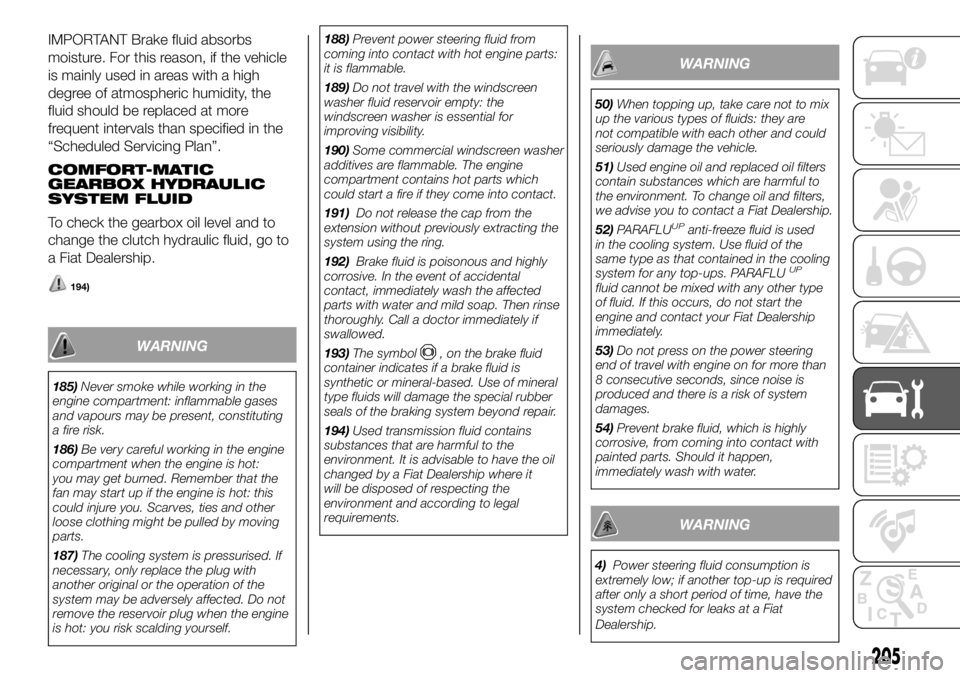
IMPORTANT Brake fluid absorbs
moisture. For this reason, if the vehicle
is mainly used in areas with a high
degree of atmospheric humidity, the
fluid should be replaced at more
frequent intervals than specified in the
“Scheduled Servicing Plan”.
COMFORT-MATIC
GEARBOX HYDRAULIC
SYSTEM FLUID
To check the gearbox oil level and to
change the clutch hydraulic fluid, go to
a Fiat Dealership.
194)
WARNING
185)Never smoke while working in the
engine compartment: inflammable gases
and vapours may be present, constituting
a fire risk.
186)Be very careful working in the engine
compartment when the engine is hot:
you may get burned. Remember that the
fan may start up if the engine is hot: this
could injure you. Scarves, ties and other
loose clothing might be pulled by moving
parts.
187)The cooling system is pressurised. If
necessary, only replace the plug with
another original or the operation of the
system may be adversely affected. Do not
remove the reservoir plug when the engine
is hot: you risk scalding yourself.188)Prevent power steering fluid from
coming into contact with hot engine parts:
it is flammable.
189)Do not travel with the windscreen
washer fluid reservoir empty: the
windscreen washer is essential for
improving visibility.
190)Some commercial windscreen washer
additives are flammable. The engine
compartment contains hot parts which
could start a fire if they come into contact.
191)Do not release the cap from the
extension without previously extracting the
system using the ring.
192)Brake fluid is poisonous and highly
corrosive. In the event of accidental
contact, immediately wash the affected
parts with water and mild soap. Then rinse
thoroughly. Call a doctor immediately if
swallowed.
193)The symbol
, on the brake fluid
container indicates if a brake fluid is
synthetic or mineralbased. Use of mineral
type fluids will damage the special rubber
seals of the braking system beyond repair.
194)Used transmission fluid contains
substances that are harmful to the
environment. It is advisable to have the oil
changed by a Fiat Dealership where it
will be disposed of respecting the
environment and according to legal
requirements.
WARNING
50)When topping up, take care not to mix
up the various types of fluids: they are
not compatible with each other and could
seriously damage the vehicle.
51)Used engine oil and replaced oil filters
contain substances which are harmful to
the environment. To change oil and filters,
we advise you to contact a Fiat Dealership.
52)PARAFLU
UPanti-freeze fluid is used
in the cooling system. Use fluid of the
same type as that contained in the cooling
system for any top-ups. PARAFLU
UP
fluid cannot be mixed with any other type
of fluid. If this occurs, do not start the
engine and contact your Fiat Dealership
immediately.
53)Do not press on the power steering
end of travel with engine on for more than
8 consecutive seconds, since noise is
produced and there is a risk of system
damages.
54)Prevent brake fluid, which is highly
corrosive, from coming into contact with
painted parts. Should it happen,
immediately wash with water.
WARNING
4)Power steering fluid consumption is
extremely low; if another top-up is required
after only a short period of time, have the
system checked for leaks at a Fiat
Dealership.
205
Page 209 of 304
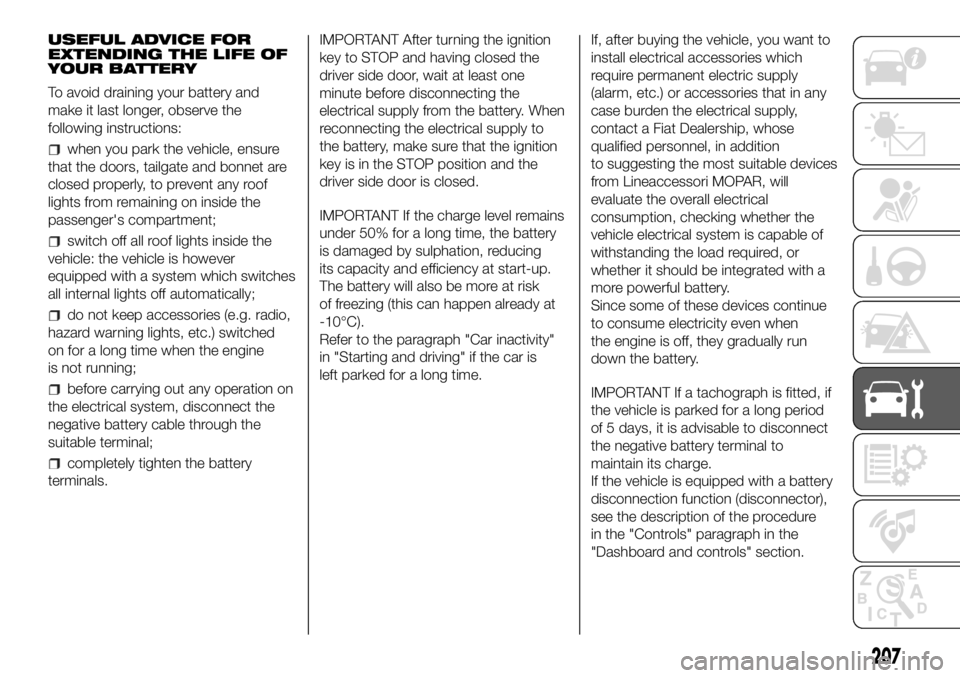
USEFUL ADVICE FOR
EXTENDING THE LIFE OF
YOUR BATTERY
To avoid draining your battery and
make it last longer, observe the
following instructions:
when you park the vehicle, ensure
that the doors, tailgate and bonnet are
closed properly, to prevent any roof
lights from remaining on inside the
passenger's compartment;
switch off all roof lights inside the
vehicle: the vehicle is however
equipped with a system which switches
all internal lights off automatically;
do not keep accessories (e.g. radio,
hazard warning lights, etc.) switched
on for a long time when the engine
is not running;
before carrying out any operation on
the electrical system, disconnect the
negative battery cable through the
suitable terminal;
completely tighten the battery
terminals.IMPORTANT After turning the ignition
key to STOP and having closed the
driver side door, wait at least one
minute before disconnecting the
electrical supply from the battery. When
reconnecting the electrical supply to
the battery, make sure that the ignition
key is in the STOP position and the
driver side door is closed.
IMPORTANT If the charge level remains
under 50% for a long time, the battery
is damaged by sulphation, reducing
its capacity and efficiency at start-up.
The battery will also be more at risk
of freezing (this can happen already at
-10°C).
Refer to the paragraph "Car inactivity"
in "Starting and driving" if the car is
left parked for a long time.If, after buying the vehicle, you want to
install electrical accessories which
require permanent electric supply
(alarm, etc.) or accessories that in any
case burden the electrical supply,
contact a Fiat Dealership, whose
qualified personnel, in addition
to suggesting the most suitable devices
from Lineaccessori MOPAR, will
evaluate the overall electrical
consumption, checking whether the
vehicle electrical system is capable of
withstanding the load required, or
whether it should be integrated with a
more powerful battery.
Since some of these devices continue
to consume electricity even when
the engine is off, they gradually run
down the battery.
IMPORTANT If a tachograph is fitted, if
the vehicle is parked for a long period
of 5 days, it is advisable to disconnect
the negative battery terminal to
maintain its charge.
If the vehicle is equipped with a battery
disconnection function (disconnector),
see the description of the procedure
in the "Controls" paragraph in the
"Dashboard and controls" section.
207
Page 216 of 304

TECHNICAL DATA
Everything you may find useful for
understanding how your vehicle
is made and works is contained in this
chapter and illustrated with data, tables
and graphics. For the enthusiasts and
the technician, but also just for those
who want to know every detail of their
vehicle.IDENTIFICATION DATA....................215
ENGINE CODES - BODYWORK
VERSION ........................................217
ENGINE ..........................................219
STEERING SYSTEM .......................222
WHEELS .........................................223
DIMENSIONS ..................................227
PERFORMANCE .............................237
WEIGHTS AND LOADS...................240
REFUELLING ..................................243
FLUIDS AND LUBRICANTS ............248
FUEL CONSUMPTION ....................251
CO2 EMISSIONS ...........................258
214
TECHNICAL DATA
Page 217 of 304
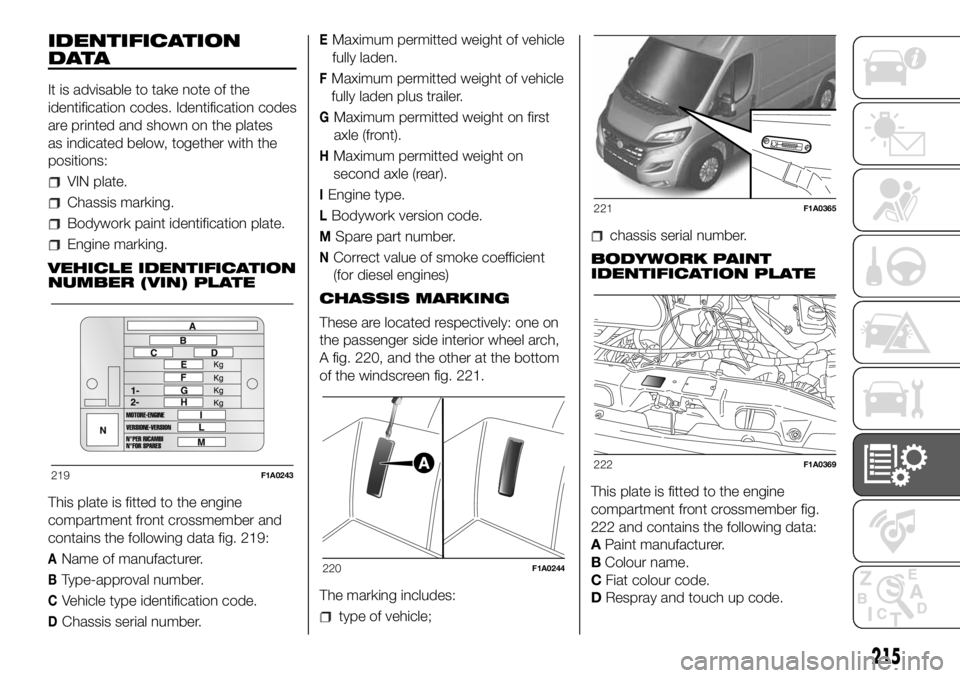
IDENTIFICATION
DATA
It is advisable to take note of the
identification codes. Identification codes
are printed and shown on the plates
as indicated below, together with the
positions:
VIN plate.
Chassis marking.
Bodywork paint identification plate.
Engine marking.
VEHICLE IDENTIFICATION
NUMBER (VIN) PLATE
This plate is fitted to the engine
compartment front crossmember and
contains the following data fig. 219:
AName of manufacturer.
BType-approval number.
CVehicle type identification code.
DChassis serial number.
EMaximum permitted weight of vehicle
fully laden.
FMaximum permitted weight of vehicle
fully laden plus trailer.
GMaximum permitted weight on first
axle (front).
HMaximum permitted weight on
second axle (rear).
IEngine type.
LBodywork version code.
MSpare part number.
NCorrect value of smoke coefficient
(for diesel engines)
CHASSIS MARKING
These are located respectively: one on
the passenger side interior wheel arch,
A fig. 220, and the other at the bottom
of the windscreen fig. 221.
The marking includes:
type of vehicle;
chassis serial number.
BODYWORK PAINT
IDENTIFICATION PLATE
This plate is fitted to the engine
compartment front crossmember fig.
222 and contains the following data:
APaint manufacturer.
BColour name.
CFiat colour code.
DRespray and touch up code.
219F1A0243
220F1A0244
221F1A0365
222F1A0369
215
Page 218 of 304
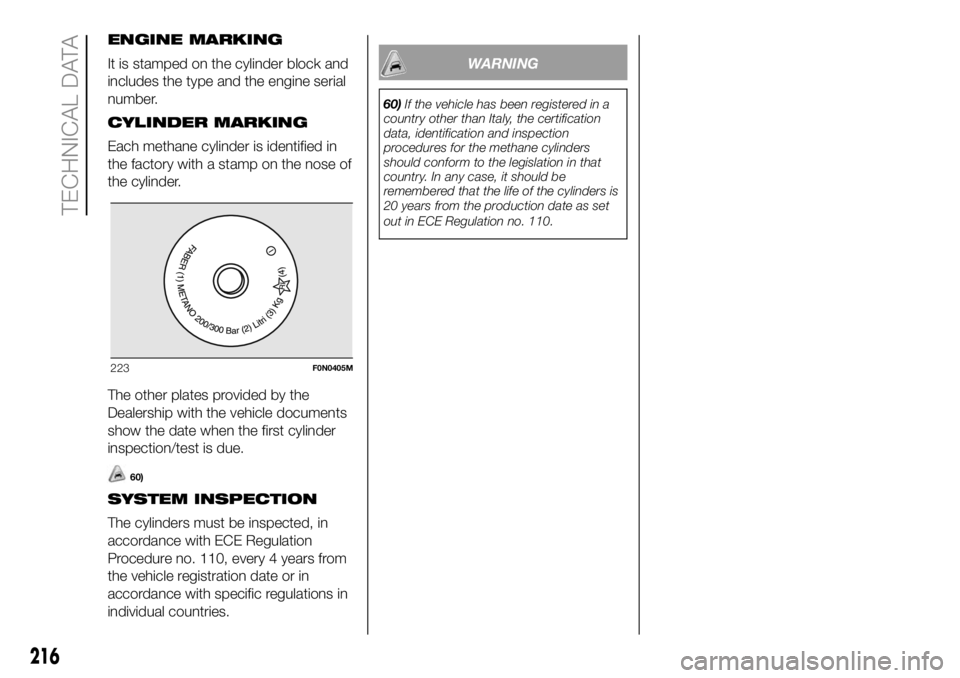
ENGINE MARKING
It is stamped on the cylinder block and
includes the type and the engine serial
number.
CYLINDER MARKING
Each methane cylinder is identified in
the factory with a stamp on the nose of
the cylinder.
The other plates provided by the
Dealership with the vehicle documents
show the date when the first cylinder
inspection/test is due.
60)
SYSTEM INSPECTION
The cylinders must be inspected, in
accordance with ECE Regulation
Procedure no. 110, every 4 years from
the vehicle registration date or in
accordance with specific regulations in
individual countries.
WARNING
60)If the vehicle has been registered in a
country other than Italy, the certification
data, identification and inspection
procedures for the methane cylinders
should conform to the legislation in that
country. In any case, it should be
remembered that the life of the cylinders is
20 years from the production date as set
out in ECE Regulation no. 110.
223F0N0405M
216
TECHNICAL DATA